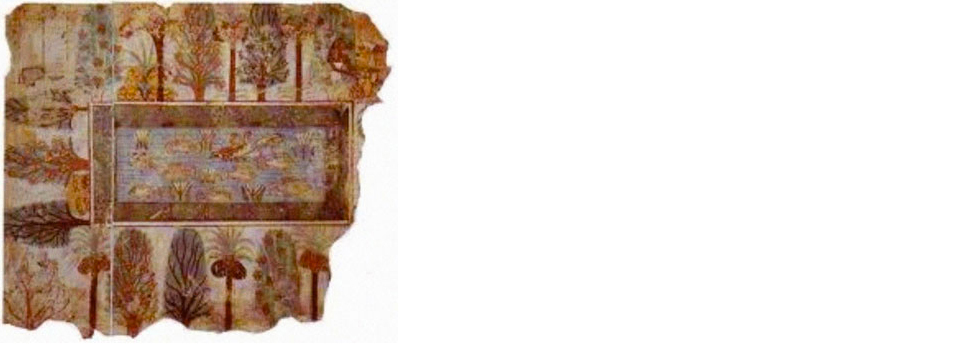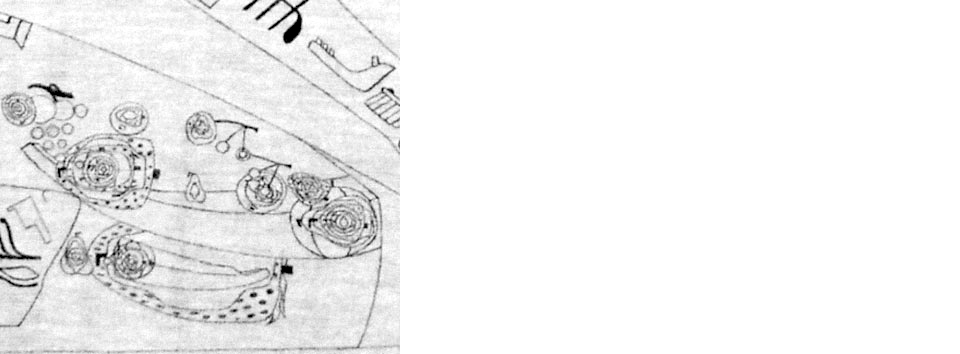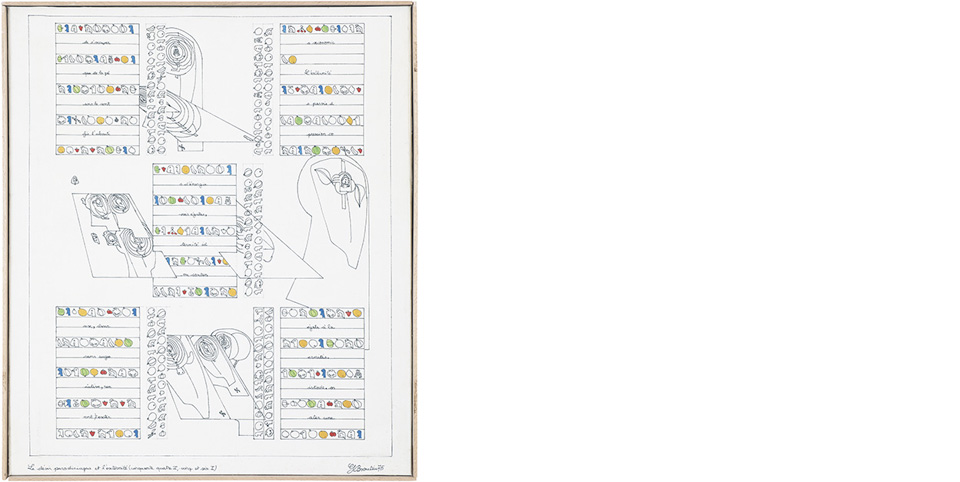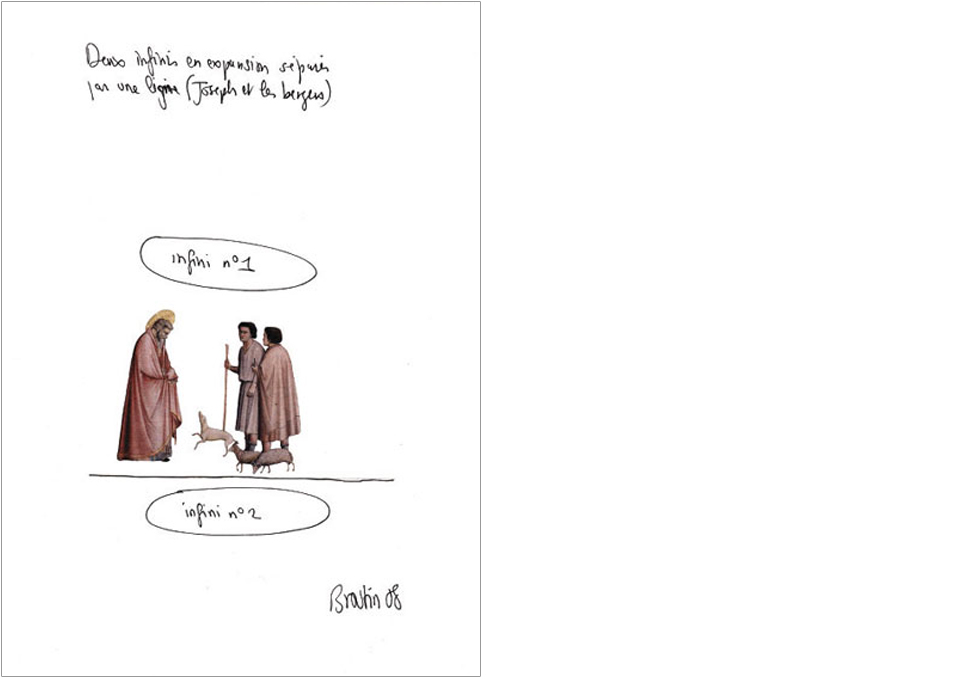
Lettrisme XXIe siècle - Reading the three texts you have in the exhibition catalog, one understands how this work that spreads over four years has layers of subjects. First, the most emotional meeting with Giotto at Assisi: "We were both exploring perspective: he in figurative art, me in Lettrism. [...] I found a brother in arms," then the polemical question of the authorship of the works, what I would call the lie of the little against the greats, or "the spiritual uniqueness" of Saint-Francis of Assisi who is leading you to reflect on your own work. Am I forgetting something?
Broutin - It is true that several themes criss-cross in this encounter with Giotto: perspective, authorship of works, and the emotion felt when facing a new beauty. Perspective first, because it is at the heart of my process ever since my first drawings in 1968. Lettrist and hypergraphic perspective, initiated through the inclusion of inclusions of letters. (In his essay entitled "Perspective," published by Mike Rose's Studio M in Bamberg, Jean-Paul Curtay characterizes this style as multi-inclusion. His effort stops at the letter as an ingredient of pictorial perspective. He does not see beyond this original element to its existing combinations in words, sentences, paragraphs, the page and clusters of pages, which had however already been explored in "The Paradisiacal Desire and the Outsider.") These inclusions of inclusions of letters create the depth of the word or sentence, then its consequences, the meta-pages in 1973 with their inclined planes and cross-sections, which reveal the theme of economics in the "Paradisiacal Desire and the Outsider," for nearly a decade, and then are picked up again in 2006 with "Desire Rediscovered." Excoordist perspective comes next, made of infinities that are expanding and bound to each other, which gave me the key to re-interpreting the work of Giotto in "The Giotto Affair III" in 2008.
Questioning the authorship of creations leads, as you state, to "the lie of the little versus the greats." In the case of Giotto, as for Picasso or Isou, the place of predecessors and successors or fellow combatants is glorified in order to diminish the contributions of the genius. Sometimes, as for Giotto, they even deny that the artist created certain works.
The emotion I felt, first in the nave of the Cathedral of Assisi in front of those scenes from the life of Saint Francis, was amplified even more before the frescos painted by Giotto and his master Cimabue, that completely cover the walls and vaults of the crypt, like in an Egyptian underground tomb.
Victim of the Stendhal syndrome, angry with those who don't want to humbly recognize genius, and motivated by the need to prolong my oeuvre, I threw myself into the cycle devoted to Giotto.
Lettrisme XXIe siècle - Let's stay for a while on perspective itself. It is really a concern for all the Lettrists, maybe even more exactly a passion, which belongs to you in particular. Can you tell us more about what made it begin and endure for you?
Broutin - What makes a passion arise and endure? In my case it all started with visits to the Museum of the Louvre at age ten – in the Egyptian antiquities – where I studied the juxtaposition of pictorial elements side by side or piled on top of each other.

Tomb of Nebamun, Thebes, 1400 BCE
Then, there was a drawing teacher in the Sèvres high school who opened the door of knowledge, and thanks to her I was finally able to render the perspective of a tree-lined avenue.

Later, fascination with solid geometry earned me the only above average grades in a mathematics course.

Encountering Lettrism did not distinguish this passion; on the contrary it reinforced it and gave it new meaning. Not having found the new esthetic material, all that was left for me was to develop my own rhythms, and that is what I applied myself to in my first works, with

"Adam", India ink on unbleached canvas, 130 x 96 cm, 1970 (detail).
inclusions of inclusions of letters, words, sentences, etc., in the "Paradisiacal Desire and the Outsider" with tilted and crossing planes,

"The Paradisiacal Desire and the Outsider", India ink and acrylic on canvas, 65 54 cm, 1976
and finally more recently by proposing the perspective of expanding and coordinated infinities in "The Giotto Affair III."

"Two Infinities in Expansion Separated by a line (Joseph and the Shepherds)",
Print and India ink on paper, 30 x 21 cm, 2008
You see, perspective is a thread that runs through all the stages of painting from its origins to where it ends up as evidence at my place in Lettrism.
Lettrisme XXIe siècle - On ne connait jamais les ressorts qui font naître une nouvelle série d'oeuvres, un prolongement inattendu. Aurais-tu quelques idées qui te trottent dans la tête ?
Broutin - To continue exploring the relations among the esthetic elements and their elastic combinations. As I revealed with the "Giotto Affair," the new perspective can serve as a grid for reinterpreting past painting.
I want to confirm this by devoting a study to Kandinsky and non-representational art.
Broutin / Giotto
TRANSLATION by David Seaman
© Lettrisme XXIe siècle / 21st Century Lettrism, JP. Gillard, Broutin